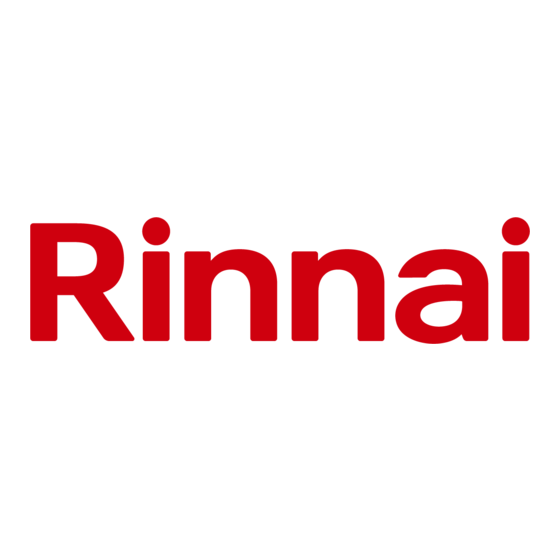
Table of Contents
Advertisement
Operating and Installation Instructions
Freestanding Royale (Australia)
Timberfl ame FS 35 (New Zealand)
IMPORTANT
This appliance shall be installed in accordance with:
Manufacturers Installation Instructions.
•
Local Gas fi tting regulations.
•
Municipal Building codes.
•
AGA Gas Installation Code AG601 - NZ 5261.
•
Any other relevant statutory regulation.
•
This appliance must only be installed, serviced and removed by an
•
authorised person.
For Australian installation, this appliance must be installed with
•
the supplied wire dressguard.
Flame Fire
Table of Contents
Customer Instructions
Installation Instructions
3
4
5
6
7
7
8
9
10
10
12
12
Advertisement
Table of Contents

Summary of Contents for Rinnai FS 35
-
Page 1: Table Of Contents
Flame Fire Operating and Installation Instructions Freestanding Royale (Australia) Timberfl ame FS 35 (New Zealand) Table of Contents Customer Instructions Operation Safety Points Troubleshooting Installation Instructions Location Flueing Gas Connection Log Installation Testing & Commissioning Technical Data Service Contacts Installation Checklist... - Page 2 5. Servicing of the product is to be carried out by a Rinnai authorised service centre. All Rinnai appliances meet or exceed the safety standards required by New Zealand gas and electrical regulations. The company is constantly improving its products and as such specifi cations are subject to change or variation without notice.
-
Page 3: Operation
POWER FAILURE • Your Rinnai Flame Fire can be used on the low and medium settings during a power failure. However, if switched off, it cannot be relit unless power is available. The appliance is protected by an overheat switch, and may cut out if used on the HIGH setting... -
Page 4: Safety Points
SAFETY POINTS Do not restrict the warm air discharge by This appliance must not be used for any pur- placing articles in front of the heater. pose other than heating. Do not spray aerosols whilst the heater is Young children should be supervised at all operating. -
Page 5: Troubleshooting
Ensure appliance fan switch is in ON position Small Soot Deposit Normal operation No action required Inadequate Flue System Call Rinnai Service Dept./Agent Soot deposit forming Log Misalignment on Glass or Logs Incorrect Gas Pressure Condensation on Glass Normal operation... -
Page 6: Location
LOCATION YOur When positioning the heater, the main points governing the location are: 1. Flueing. 2. Warm air distribution. 3. The heater must not be installed where curtains or other combustible materials could come into contact with it. In some cases, curtains may need restraining. See below for minimum clearances required. -
Page 7: Flueing
FLUEING This heater requires a minimum 3m. fl ue. • Position the heater. • Suspend a plumbline from the ceiling to • the centre of the fl ue socket. • Mark the centre of the fl ue in the ceiling. •... -
Page 8: Log Installation
LOG INSTALLATION he logset is packed inside the heater and the packaging must be removed prior to installing the logset in its correct position. • Open both side panels. • Remove fastenings on both sides of the top glass retainer. Lift retainer away from heater. -
Page 9: Testing & Commissioning
INSTRUCT CUSTOMER ON USE OF UNIT • Explain to customer about use and care of unit. Make sure the customer understands the instructions. EXPLAIN • Ignition, Adjusting heat level, Fan Switch, Turning “OFF”. NOTE: RINNAI RESERVES THE RIGHT TO CHANGE OR MODIFY SPECIFICATIONS WITHOUT NOTICE. -
Page 10: Technical Data
FGL35 FBN (NG) Australia FGL35 FBL (Propane) Australia FS35N (NG) New Zealand FS35L (Propane) New Zealand Description: Rinnai Inbuilt Radiant/Convector, glass-fronted, ceramic log space heater with forced convection and natural draught fl ue system. Input: 35 MJ/h Natural Gas and Propane. Gas Control: Rinnai Push-Button Combination Control. -
Page 12: Installation Checklist
INSTALLATION / COMMISSIONING CHECKLIST (To be completed by certifi ed Gas Installer) ____________________ Model: 1. Was a fi replace inspection carried out? (ie. clearances, combustibles etc.) 2. Was chimney inspected? 3. Did chimney require fl ue liner system to be installed? If NO, did chimney meet specifi...












Need help?
Do you have a question about the FS 35 and is the answer not in the manual?
Questions and answers